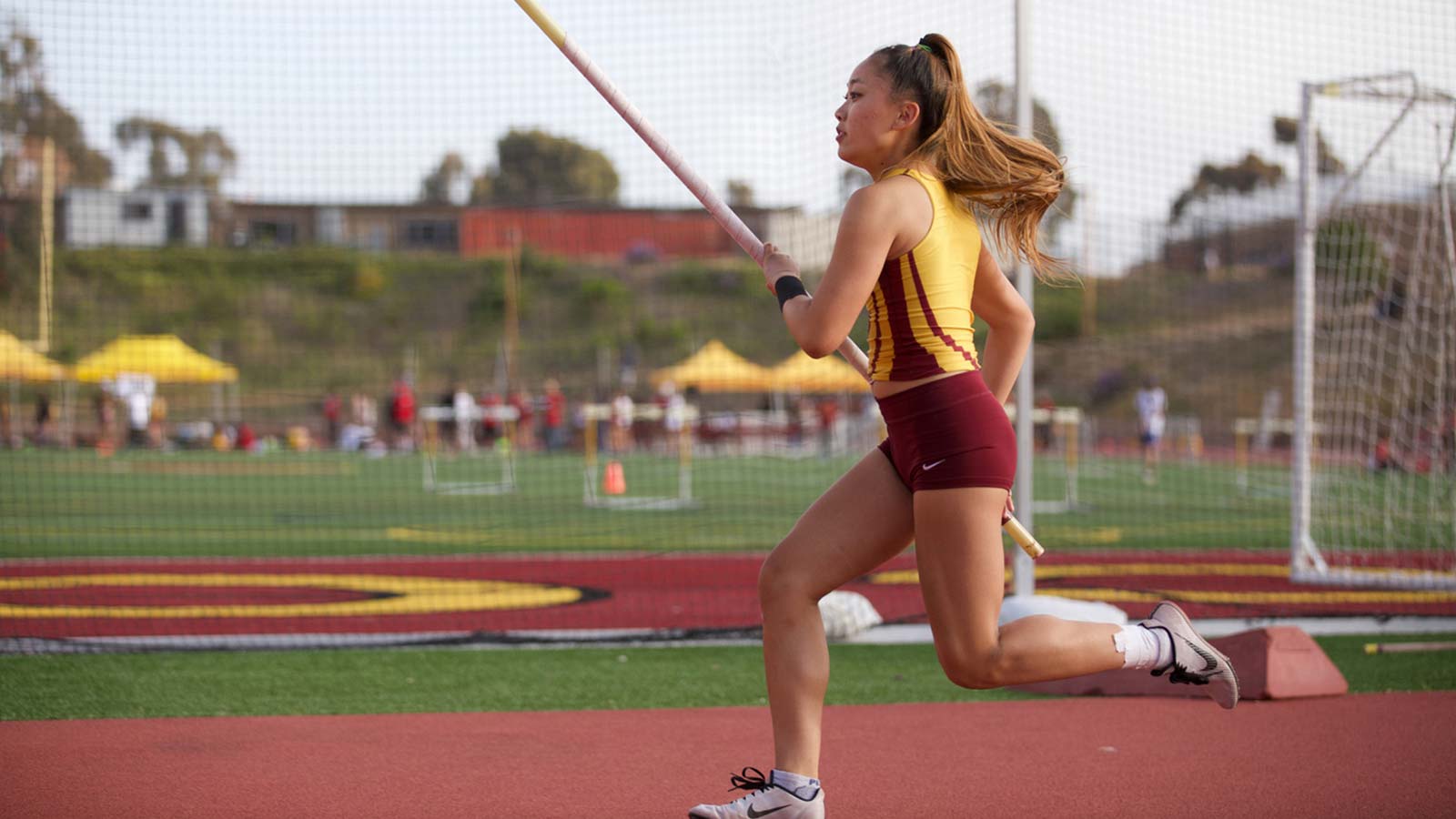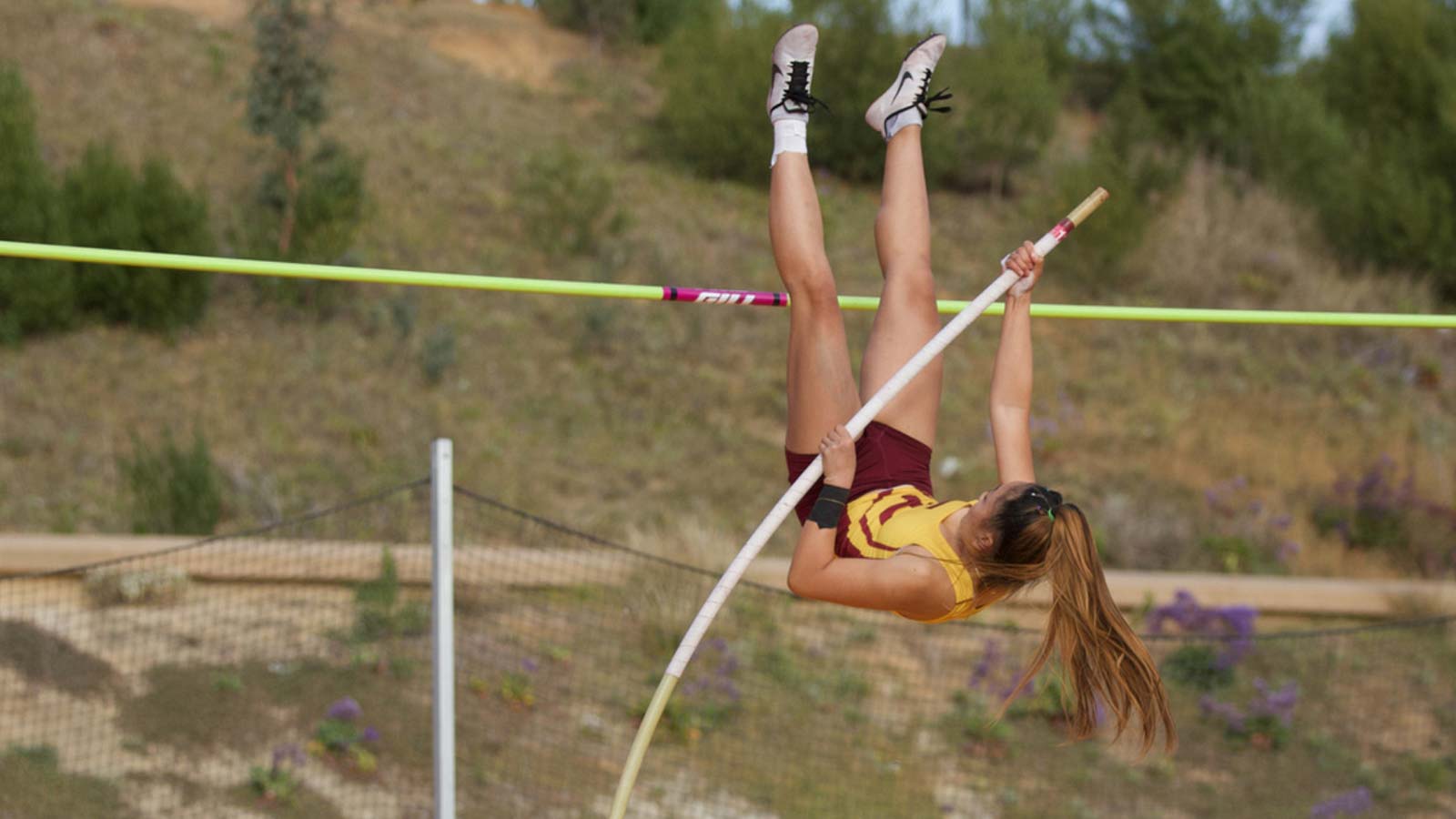OFFICIATING THE POLE VAULT – CLICK HERE FOR PDF
- Athletes must compete in school issued uniforms. Any undergarments must be one solid color. Not cut-offs, no football jersey.
- No jewelry may be worn. Watches, religious medals, and medic alert jewelry are the only allowable jewelry. Such allowable jewelry must be taped down.
- Vaulters have 1½ minutes to compete once their name has been called. When 3 or less competitors are left, they will have 4 minutes to compete. A single competitor is allowed 6 minutes.
- Vaulters may not use any weights or artificial aids.
- The competitor’s weight must be at or below the manufacturer’s pole rating. The pole rating must be a minimum of ¾ “ and marked above the band indicating the maximum top hand-hold position.
- The coach must verify a vaulter’s weight to insure that he is using a legal pole. Weigh-in includes shoes with uniform.
- Tape on a vaulter’s pole may not exceed two layers.
- The landing pad must be a minimum of 16’ 5” by 19’ 8”. A front pad shall be 16’ 5” wide and reach to the front edge of the planting box. A common cover is required. The crossbar must be at least 14’ 10” long. Hard or unyielding surfaces around the pit must be padded with at least 2” of dense foam.
- No markers may be placed on the runway, but it is permissible to place markers at the side of the runway.
- Three consecutive misses eliminates a competitor, regardless of the heights.
- A competitor who has passed three consecutive heights may be permitted one warm-up jump without the crossbar in place. The competitor must enter the competition at that height. The warm-up jump takes place when the bar has been moved to a new height.
- A continuing flight is 3 to 5 jumpers competing in a flight. As a participant clears the bar, passes the height, or is eliminated from competition, the next competitor on the list is added to the flight.
- A cloth marker may be placed on the crossbar for sighting purposes.
- Standards must be secured in a way so as to prevent them from tipping over.
- Standards must be set so that the crossbar is in a position from 15.5” to 31.5” beyond the vertical plane of the back of the planting box.
- No tape is allowed on the hands or fingers unless there is an open cut or wound that needs to be protected. Gloves are not permitted.
- If a pole breaks, it does not count as an attempt.
- The planting box shall not contain any foreign materials.
- If there is a tailwind, a pole catcher may be assigned.
- Measurements of the bar for records are taken before competitors begin jumping at a height. Measurement is to the lesser ¼ inch. Measurement is made from the ground perpendicular to the crossbar at its lowest point. Read the measurement at the
- top side of the crossbar.
- The bar may not be lowered after the competition has started, except in the case of a jump-off.
- A competitor is disqualified from the event if he uses a training pole, an improperly marked pole, or a pole rated below his/her weight during warm-up or in competition.
- It is an unsuccessful trial if:
a) The crossbar is knocked down by the body or the pole.
b) When a jumper touches the ground or landing area beyond the vertical plane of the stopboard without clearing the crossbar.
c) When, after clearing the bar, the competitor stumbles against the upright and knocks down the bar, or he steadies the bar with his hands.
d) After takeoff, the hand which is highest on the pole shall not be raised to a higher point, and neither shall the lower hand be raised above the upper hand.
e) Fails to jump in the allotted 1½ minutes.
f) The vaulter grips the pole above the hand hold band on the pole - Excused to compete in another event:
a) The athlete must receive permission from the event judge.
b) The judge may allow the competitor to take a trial out of turn before being excused.
c) The judge must record the time excused.
d) The judge will use some judgment in extending the time excused under special circumstances. 10 minutes is normal, but may be extended in a case such as the 3200 m. run. - Breaking Ties:
- 1st criteria: The competitor with the lowest number of trials for the height at which the tie occurs, shall be awarded the higher place.
- If a tie remains, the person with the lowest total of misses throughout the competition shall be awarded the higher place.
- If a tie still remains:
- If it is for other than 1st place, the competitors will be awarded a tie for the same place.
- If it is a tie for first place, a jump off must be held. Tying competitors will have one more attempt at the last height failed. If they both fail, the bar is lowered 3” and each competitor is given one attempt. If they both make it, the bar is raised 3” and one attempt is given each. If they both miss it, the bar is lowered 3”and one attempt is given each athlete. This is continued until a winner is determined. If a height cleared in the jump-off is higher than the height in the regular competition, the higher height is recorded as the winning height.


